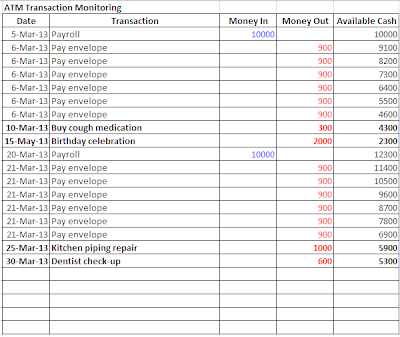I used to be a control freak -- and maybe I still am -- when it comes to money. If after a few days I couldn't tell where did say my 13th month pay had gone, I would freak out. Finally, I decided to list all my non-regular, non-repetitive and unexpected expenses like repair bills, medical bills, birthday party bills, gifts, etc. in a spreadsheet called Non-regular Expenses. This is on top of the Regular Expenses spreadsheet I posted earlier. This way no expenses, regular or not, should escape my attention, so I thought.
At first it worked until I started to miss writing one expense item, then two, then three, and so on and so forth. In short, I couldn't keep up. You see, when I decided to incorporate the Non-regular Expense spreadsheet in my money management method, I forgot that I didn’t have the luxury of free time being a family man with five children, a wife and a full time job, all vying for my attention. So I decided to change strategy.
The first thing that came to my mind was to simplify my method of monitoring all my expenses to make it more sustainable. Later, after much thought, I realized that I could incorporate all of my non-regular expenses into an existing spreadsheet called ATM Transaction Monitoring sheet. I used this spreadsheet to track down all the money that went in and out of my ATM account.
So instead of maintaining two spreadsheets, the ATM Transaction Monitoring and the Non-Regular Expenses, I only need to update one spreadsheet which was more sustainable.
So I began working on it. The spreadsheet below is what an ATM Transaction Monitoring spreadsheet looks like. Please take note that I made up the amounts in order to protect my privacy.
Here's a quick explanation of the content of this spreadsheet.
The column Money In represents the money that is deposited into my ATM, e.g., payroll while the column Money Out refers to all withdrawals. The Available Cash column refers to the balance and is solved using the formula,
Available Cash (row 2) = Available Cash (row 1) + Money In (row 2) - Money Out (row 2)
The four transactions in bold represents all of my non-regular expenses from March 5~30,2013.
Using this spreadsheet, I can see quickly how much money went into my ATM and where this came from, and how much money went out from it and where this went to. This helps me track my cash flow quickly.
Btw, if you are curious about the transaction Pay envelope click here to know more about this simple yet very powerful money management tool.
That's it folks. Till next time.
PS: I don't claim to be an expert in money management. I'm just an ordinary Pinoy who wants to share to you simple and practical ideas that I have learned and applied for over 10 years of deliberately managing my finances. Managing finances is one of the most important tasks of every person, yet so neglected by many. It is my hope that you will find the ideas here useful. Whether you agree or disagree, please do write your comments below. I love to hear from you and hopefully exchange ideas and opinions. After all learning is a continuous process.

No comments:
Post a Comment